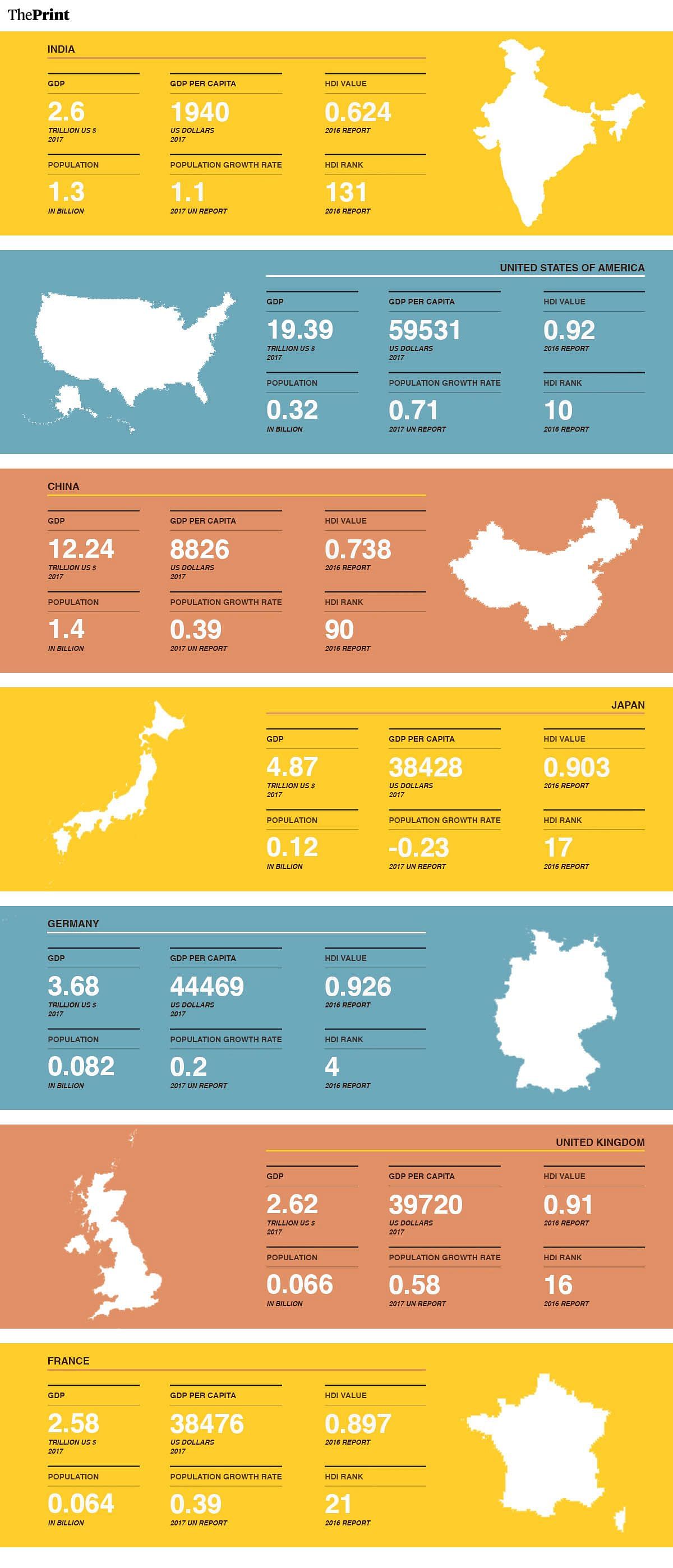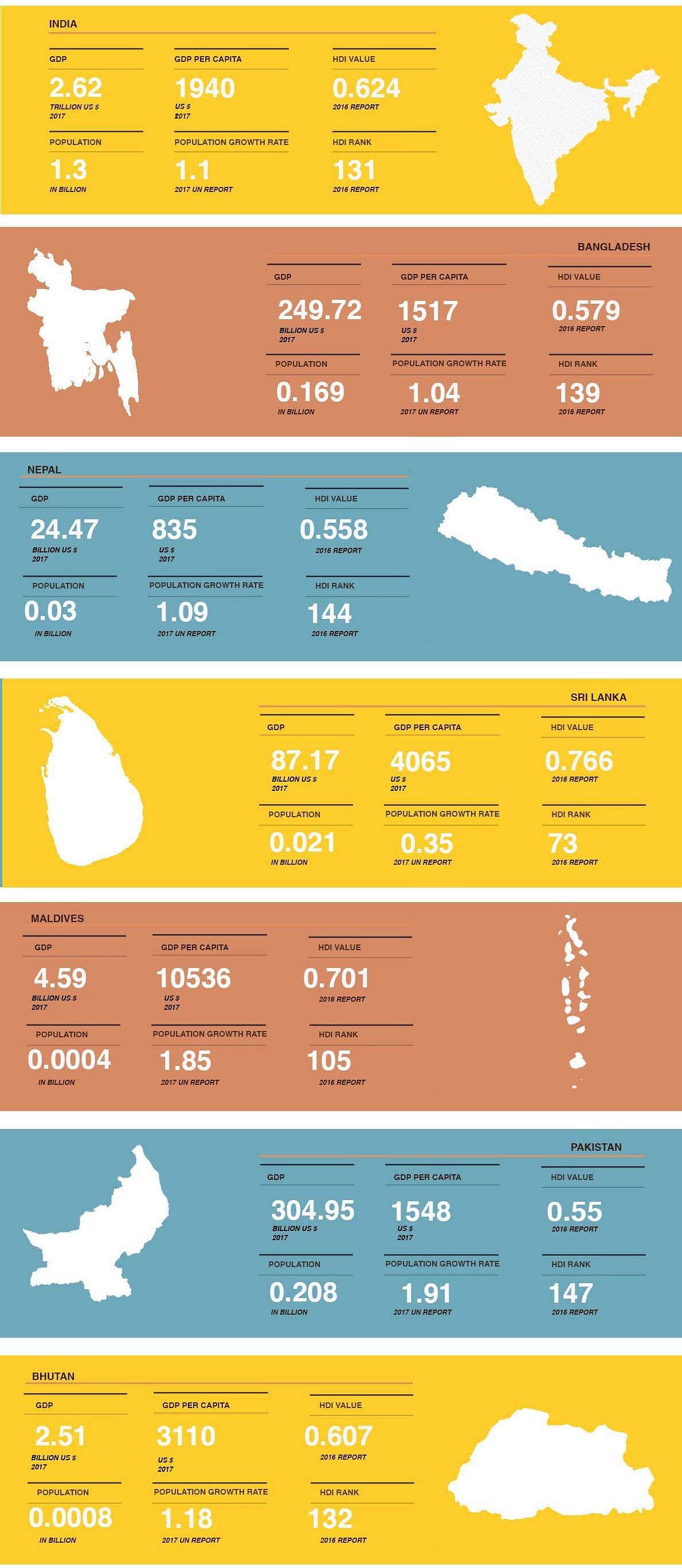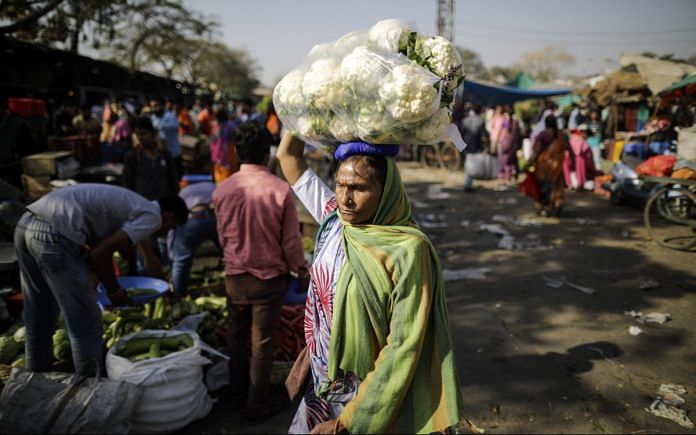GDP per capita of $1,940 shows the average Indian is less prosperous than those in some of our neighbouring countries.
New Delhi: India is now the sixth largest economy in the world with a Gross Domestic Product (GDP) of $2.597 trillion, according to World Bank data for 2017, updated this week. It has surpassed, among other countries, France which has a GDP of $ 2.582 trillion.
The data points to a rapidly growing economy, but a deeper look at the numbers tells a different story — of the overall growth not percolating down to those in the lower rungs of the economic chain.
Although India has beaten France in the overall GDP list, when it comes to GDP per capita — the measure that indicates the standard of living — the country comes nowhere close to the European giant. France has a GDP per capita of $38,476, while India’s is at $1,940.

India’s GDP per capita is also nowhere near the top five countries in the overall GDP list — the US has a per capita of $59,531, the figure for China is $8,826, for Japan it’s $38,428, for Germany it’s $44,469 and for the UK it is $39,720.
India’s GDP per capita is even lower than its Asian neighbours — Sri Lanka has a GDP per capita of $4,065, the Maldives has $10,536, while Bhutan has a GDP per capita of $3,110.
The population argument
Critics will argue that India, with its population of 1.3 billion people, the second highest in the world, can’t be compared with a France, US or even Sri Lanka, which have populations of 0.064, 0.32 and 0.021 billion respectively.
But even then, India’s per capita income is four times less than that of China, the most populous country in the world.
Also, when looking at the population, two important aspects need to be taken into account — the growth rate of the population and the socio-economic conditions of the population.
Developed countries such as France, Germany, UK have all brought their population growth to under 1 per cent, while India’s population growth rate is 1.1 per cent. This may not look too bad in comparison, but it is tellingly poor when compared to our Asian neighbours.

Bangladesh, for instance, has a per capita income of $1,517 and GDP of $249.7 billion. It has, however, brought down its population growth rate from 2.23 per cent in the 1990s to 1.04 per cent today. Whereas, compared to a population growth rate of 1.98 per cent in the 1990s, India’s growth rate has dropped to 1.10 per cent.
India also performs poorly on the Human Development Index (HDI), a metric developed by the United Nations that is considered the standard measure of quality of life across the world. While India is ranked 131 on the HDI index, neighbours such as Sri Lanka and Maldives rank 73 and 105 respectively.
Sri Lanka also boasts of a population growth of just 0.35 per cent.
All of this implies that while the Indian economy is growing, resources and benefits are not being distributed equally.
Pakistan seems to be lost today in this shift with an economy of $304.9 billion, but a huge growth rate of 1.91 per cent and HDI rank of 147.







This is very thoughtful article proving phony hype created by ruling elites to hide concentration of wealth going to very small %of population and talking points to ruling party to hide failure.
I don’t know the kind of research you actually do before publishing a story. When u compare living standards u compare pay per parity. For example france may be having a huge gdp per capita but that does not indicate huge purchasing power. $70000 is equivalent to 13lakh rupees adjusted to purchasing power.
Also per capita ignores the variance in data. One billionaire is enough to indicate a higher gdp per capita but the variance may be huge. In essential gdp per capita is not a good statistic to measure whether wealth is percolating to lower rungs of society.
Please do proper research before posting such stories
This article is nothing more than scaremongering. The reason India has been lagging in figures lately was because of mismanagement. But now things have started to change. Sanitation, electrification and other such essentials are likely to be completed in the next few months. This will in turn push the HDI higher.
Although curbing population did help China, it will bring them newer problems in about a decade. China’s workforce has started shrinking since 2013 and their overall population will start shrinking from 2030. This will inform cause their economy to slow down but their per capita income will increase sharply like Japan’s.
An economy should have a population growth relative to its size. China is already at the low fertility trap (1.3 TFR) at 1.2, even lower than Japan’s 1.4 despite not even having graduated to a high income economy yet.
India’s parameters will likely improve by leaps and bounds in the next few years.
Also, China has less habitable land than India. 2/3rd of China is inhospitable. 94% of the population live on the east side alone.
Even if Indian economy grows by double digits, we won’t graduate to a high income economy until mid 2030s. We should have an economy of around $10-12T around 2030 ideally.
This is not a Congress versus BJP debate. The fact of the matter is that impressive economic growth is overtaken by faster population growth. Before someone says China, let me point out that China is three times as large as India and that means a much larger supply of natural resources. China’s population density is 135 per sq km to India’s 455.
If economic growth has to trickle down to the individual citizen, population growth has to be tackled aggressively. If Bangladesh and Sri Lanka can do it, why not India.
That’s mostly an incorrect statement. 2/3rds of China is empty barren desert and highlands, the entire population is concentrated in the Eastern 1/3 which makes it’s effective density same as India. In addition, India actually has 50% more arable land than China with longer growing season (more warm climate in India). China is ahead because they started economic reforms sooner and simply a matter of compounding growth over a longer period of time which just shows the importance of showing urgency in economic growth. China also killed 60 million of their citizens in the great leap forward under Mao which reduced their population.
The comparison is not just with China. A landmark paper presented in the United Nations describes how the two pronged strategy of population control and economic liberalization catapulted China on the path of economic growth. The world population bureau has studied all so called economic miracles of Asia and in each case drastic reductions in fertility rate has been part of the strategy for economic development.
This is true whenever we talk of GDP of India. Why author tells all these only now?
When Congress ruled and when Go t. claimed better GSP the same person should have pronounced all that’s information.
As I know China and India have wealth distribution problem and only countries where population is less the per capita figures may more or less tally
These are well known statistics. By no stretch of the imagination can India be termed a well-off country, and conditions are not perfect. But there is steady growth, which is cause for cautious optimism.
The author uses low GDP per capita as an indicator of benefits not being distributed equally, “All of this implies that while the Indian economy is growing, resources and benefits are not being distributed equally.”
While, the benefits of a high GDP are not being distributed equally is probably true it cannot be considered as an implication of low GDP per capita. Low GDP per capita as compared to other countries actually implies that if all of the GDP was divided ‘equally’ among the population in a country it would leave each person in the country with very little as compared to people in other countries. So essentially even though India’s GDP is very big it is not big enough for everyone in the country to have a big amount. For example with our current population of 1.2 billion if want each person in India to have the gdp per capita of France around $38,000 we would need India’s GDP to be at approx 45 trillion, to be at Maldives level of around $10,000 we need the GDP to be at 12 trillion. So if our GDP gets to $12 trillion in the 2030’s as the article predicts we might be at what Maldives is at currently.
Point being the focus on GDP is bogus, to even start talking about any meaningful measure of the well being of people in a country we need to start of with per capita GDP.
Absolutely.
India became independent in 1947 and China a year later in 1948 .China is more populous than India.Yet its per capita income is four times that of India.This single statistic alone shows how shoddily Congress and its allies which were ruling India most of the years since independence had mismanaged the Indian economy.
Actually, Congress leaders have no moral right to criticize the present government as Congress is the party which has let down the country on many fronts through its inept handling of the country’s affairs.
Hahaha, typical shoddy dimwitted analysis from a dimwitted journo posing as an economist. Reminds me of an article by surjit bhalla – Job gains versus fake analysis. Trying your best to deflate a happy news for the economy. Resources not being distributed, holy pedo ( for the liberals) and cow (for the Hindus)!!!
I think she completely misses or has such a miniscule brain and critical thinking ability that she overlooks the rate of decrease in poverty according to World Bank recently. Anyways, nothing better can be expected from the dawood chelas.
Oh and don’t go crying feminism because i made fun of a woman journo, believe i wouldve treated a man with much harsher words.
Absolutely correct, this pseudo sickular and liberal news agencies are far more problematic than terrorism.
Your are another problem India faces, the author failed to mention in the article. easily offended mentality of most of the Indians.
It is true that India has a problem with the distribution of wealth but the trend, however, is encouraging. It is unfair to label the situation based on current statics alone which does not capture the trends
Trend is towards concentration of wealth, not dispersion.
The trends at current rate will take a hundred years to make perceptible change. Every developed country has reined in population and India cannot be an exception.
Sixth largest after passing France, fifth when we overtake Britain shortly. The euphoria lasts thirty seconds, till we see the 20 : 1 differential in population. Somehow, we go more by special effects than substance.